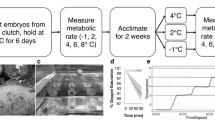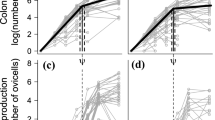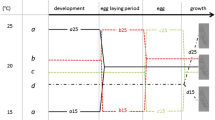Abstract
Age and size at maturation are important correlates of fitness in many organisms and understanding how these are influenced by environmental conditions is therefore required to predict populations’ responses to environmental changes. In ectotherms, growth and maturation are closely linked to temperature, but nonetheless it is often unclear how temperature-induced variation in growth and temperature per se translate to the process of maturation. Here, we test this explicitly with a common garden experiment using nine-spined sticklebacks (Pungitius pungitius). We reared fish in 14 and 17°C and recorded high resolution growth trajectories and the timing of maturation on an individual basis. To characterize the growth of each individual, we fitted a von Bertalanffy growth curve to each measured growth trajectory, so that the three parameters of the curve provided a summary of an individual’s growth. Temperature treatments induced changes in both the growth parameters and the age at maturation. In females, changes in the age of maturation were encompassed by variations in growth, whereas in males there was a temperature-related shift in the age at maturation that was unrelated to growth. Our experiment demonstrates that temperature can affect maturation directly, and not only through temperature-induced changes in growth. Therefore, one cannot predict, on the basis of growth only, how changes in temperature might alter age and size at maturation and the subsequent reproduction.


Similar content being viewed by others
References
Allen JRM, Wootton RJ (1982) The effect of ration and temperature on the growth of the three-spined stickleback, Gasterosteus aculeatus L. J Fish Biol 20:409–422
Angilletta JR (2009) Thermal adaptation: a theoretical and empirical synthesis, 1st edn. Oxford University Press, USA
Atkinson D (1996) Ectotherm life-history responses to developmental temperature. In: Johnston IA, Bennett AF (eds) Animals and temperature: phenotypic and evolutionary adaptation. Cambridge University Press, Cambridge, pp 183–204
Atkinson D, Sibly RM (1997) Why are organisms usually bigger in colder environments? Making sense of a life-history puzzle. Trends Evol Environ 12:235–239
Bănărescu PM, Paepke H-J (2001) The freshwater fishes of Europe, vol 5/III. AULA, Wiebelsheim
Barot S, Heino M, O’Brien L, Dieckmann U (2004) Estimating reaction norms for age and size at maturation when age at first reproduction is unknown. Evol Ecol Res 6:659–678
Beacham TD, Murray CB (1990) Temperature, egg size, and development of embryos and alevins of five species of pacific salmon: a comparative analysis. Trans Am Fish Soc 119:927–945
Bell MA, Foster SA (eds) (2004) The evolutionary biology of the threespine stickleback. Oxford University Press, Oxford
Berner D, Blackenhorn WU (2007) An ontogenetic perspective on the relationship between age and size at maturity. Funct Ecol 21:505–512
Berrigan D, Charnov EL (1994) Reaction norms for age and size at maturity in response to temperature: a puzzle for life historians. Oikos 70:474–478
Borg B, Bornestaf C, Hellqvist A, Schmitz M, Mayer I (2004) Mechanisms in the photoperiodic control of reproduction in the stickleback. Behaviour 141:1521–1530
Charnov EL (1982) The theory of sex allocation. Princeton University Press, Princeton
Dembski S, Masson G, Monnier D, Wagner P, Pihan JC (2006) Consequences of elevated temperatures on life-history traits of an introduced fish, pumpkinseed Lepomis gibbosus. J Fish Biol 69:331–346
Dhillon RS, Fox MG (2004) Growth-independent effects of temperature on age and size at maturity in Japanese Medaka (Oryzias latipes). Copeia 2004:37–45
Dieckmann U, Heino M (2007) Probabilistic maturation reaction norms: their history, strengths, and limitations. Mar Ecol Prog Ser 335:253–269
Fischlin A, Midgley GF, Price JT, Leemans R, Gopal B, Turley C, Rounsevell MDA, Dube OP, Tarazona J, Velichko AA (2007) Ecosystems, their properties, goods, and services. In: Parry ML, Canziani OF, Palutikof JP, van der Linden PJ, Hanson CE (eds) Climate change 2007: impacts, adaptation and vulnerability. Contribution of Working Group II to the Fourth Assessment Report of the Intergovernmental Panel on Climate Change. Cambridge University Press, Cambridge, pp 211–272
Fonseca VF, Cabral HN (2007) Are fish early growth and condition patterns related to life-history strategies? Rev Fish Biol Fish 17:545–564
Fox MG, Crivelli AJ (2001) Life history traits of Pumpkinseed (Lepomis gibbosus) populations introduced into warm thermal environments. Arch Hydrobiol 150:561–580
Grift RE, Rijnsdorp AD, Barot S, Heino M, Dieckmann U (2003) Fisheries-induced trends in reaction norms in North Sea plaice. Mar Ecol Prog Ser 257:247–257
Heino M, Dieckmann U, Godø OR (2002) Measuring probabilistic reaction norms for age and size at maturation. Evolution 56:669–678
Heins DC, Johnson JM, Baker JA (2003) Reproductive ecology of the nine-spined stickleback from south-central Alaska. J Fish Biol 63:1131–1143
Heins DC, Baker JA, De Silva G, Birden EL (2005) Clutch characteristics of two populations of nine-spined stickleback from south-central Alaska. J Fish Biol 67:873–878
Hellqvist A, Bornestaf C, Borg B, Schmitz M (2004) Cloning and sequencing of the FSH-beta and LH beta-subunit in the three-spined stickleback, Gasterosteus aculeatus, and effects of photoperiod and temperature on LH-beta and FSH-beta mRNA expression. Gen Comp Endocrinol 135:167–174
Herczeg G, Gonda A, Merilä J (2009) Evolution of gigantism in nine-spined sticklebacks. Evolution 63:3190–3200
Herczeg G, Gonda A, Merilä J (2010) Rensch’s rule inverted–female-driven gigantism in nine-spined stickleback Pungitius pungitius. J Anim Ecol 79:581–588
Jennings S, Greenstreet SPR, Reynolds JD (1999) Structural change in an exploited fish community: a consequence of differential fishing effects on species with contrasting life-histories. J Anim Ecol 68:617–627
Jones JW, Hynes HBN (1950) The age and growth of Gasterosteus aculeatus, Pygosteus pungitius and Spinachia vulgaris as shown by their otoliths. J Anim Ecol 19:59–73
Jørgensen C, Enberg K, Dunlop ES, Arlinghaus R, Boukal DS, Brander K, Ernande B, Gårdmark A, Johnston F, Matsumura S, Pardoe H, Raab K, Silva A, Vainikka A, Dieckmann U, Heino M, Rijnsdorp A (2007) Managing evolving fish stocks. Science 318:1247–1248
Kraak SBM (2007) Does the probabilistic maturation reaction norm approach disentangle phenotypic plasticity from genetic change? Mar Ecol Prof Ser 335:295–300
Kuparinen A, O’Hara RB, Merilä J (2008) The role of growth history in determining the age and size at maturation. Fish Fish 9:201–207
Lachance S, Magnan P, FitzGerald GJ (1987) Temperature preference of three sympatric sticklebacks (Gasterosteidae). Can J Zool 65:1573–1576
Law R (2007) Fisheries induced evolution: present status and future directions. Mar Ecol Prog Ser 335:271–277
McKenzie W, Crews D, Kallman KD, Policansky D, Sohn JJ (1983) Age, weight and the genetics of sexual maturation in the platyfish Xiphophorus maculatus. Copeia 1983:770–774
McLennan DA, Ryan MJ (1997) Responses to conspecific and heterospecific olfactory cues in the swordtail Xiphophorus cortezi. Anim Behav 54:1077–1088
Meehl GA, Stocker TF, Collins WD, Friedlingstein P, Gayen AT, Gregory JM, Kitoh A, Knutti R, Murphy JM, Noda A, Raper SCB, Watterson IG, Weaver AJ, Zhao Z-C (2007) Global climate projections. In: Solomon S, Qin D, Manning M, Chen Z, Marquis M, Averyt KB, Tignor M, Miller HL (eds) . Climate Change 2007: The Physical Science Basis. Contribution of Working Group I to the Fourth Assessment Report of the Intergovernmental Panel on Climate Change, 1st edn, pp 747–845 Cambridge University Press, Cambridge
Melbourne BA, Hastings A (2008) Extinction risk depends strongly on factors contributing to stochasticity. Nature 454:100–103
Meyers JL, Sale MJ, Mulholland PJ, Poff NLR (1999) Impacts of climate change on aquatic ecosystem functioning and health. J Am Water Res Assoc 35:1373–1386
Morita K, Tsuboi J, Nagasawa T (2009) Plasticity in probabilistic reaction norms for maturation in a salmonid fish. Biol Lett 5:628–631
Murray CB, McPhail JD (1988) Effect of incubation temperature on the development of five species of Pacific salmon (Oncorhynchus) embryos and alevins. Can J Zool 66:66–273
Nagelkerke NJD (1991) A note on a general definition of the coefficient of determination. Biometrika 78:691–692
Ojanguren AF, Reyes-Gavilán FG, Braña F (2001) Thermal sensitivity of growth, food intake and activity of juvenile brown trout. J Therm Biol 26:165–170
Olsen EM, Heino M, Lilly GR, Morgan MJ, Brattey J, Ernande B, Dieckmann U (2004) Maturation trends indicative of rapid evolution preceded the collapse of northern cod. Nature 428:932–935
Östlund-Nilsson S, Mayer I, Huntingford F (2007) Biology of the three-spined stickleback, 1st edn. CRC Press, Boca Raton
Pauly D, Christensen V, Dalsgaard J, Froese R, Torres F (1998) Fishing down marine food webs. Science 279:860–863
Plaistow SJ, Lapsey CT, Beckerman AP, Benton TG (2004) Age and size at maturity: environmental variability and developmental thresholds. Proc R Soc Lond B 271:919–924
Policansky D (1983) Size, age and demography of metamorphosis and sexual maturation in fish. Am Zool 23:57–63
R Development Core Team (2009) R: A language and environment for statistical computing. R Foundation for Statistical Computing, Vienna, Austria. ISBN 3-900051-07-0, http://www.R-project.org
Räsänen K, Kruuk LEB (2007) Maternal effects and evolution at ecological time-scales. Funct Ecol 21:408–421
Reznick DN (1993) Norms of reaction in fishes. In: Stokes TK, Law R (eds) Proceedings of the Conference on the Management and Exploitation of Evolving Resources. Springer, New York, pp 72–90
Robinson BW, Wardrop SL (2002) Experimentally manipulated growth rate in three spine stickle backs: assessing trade-offs with developmental stability. Environ Biol Fish 63:67–78
Rodd FH, Reznick DN, Sokolowski MB (1997) Phenotypic plasticity in the life-history traits of guppies: responses to social environment. Ecology 78:419–433
Roff DA (1992) The evolution of life-histories. Chapman & Hall, USA
Rohlf FJ (2002) tpsDig, digitize landmarks and outlines, version 1.37. Department of Ecology and Evolution, State University of New York at Stony Brook
Shackell NL, Frank KT, Fisher JA, Petrie B, Leggett WC (2010) Decline in top predator body size and changing climate alter trophic structure in an oceanic ecosystem. Proc R Soc Lond B 277:1353–1360
Sibly RM, Atkinson D (1994) How rearing temperature affects optimal adult size in ectotherms. Funct Ecol 8:486–493
Sohn JJ (1977) Socially induced inhibition of genetically determined maturation in the platyfish, Xiphophorus maculatus. Science 195:199–200
Sokolowska E, Kulczykowska E (2009) Environmental influence on maturation and dominance relationships in the three-spined stickleback (Gasterosteus aculeatus L.): temperature competes with photoperiod for primacy. Ocean Hydrobiol Stud 38:31–48
Stearns SC (1992) The evolution of life histories, 1st edn. Oxford University Press, Oxford
Stearns SC, Koella JC (1986) The evolution of phenotypic plasticity in life-history traits: predictions for reaction norms for age and size at maturity. Evolution 40:893–913
Trexler JC, Travis J, Trexler M (1990) Phenotypic plasticity in the sailfin molly, Poecilia latipinna (Pisces: Poeciliidae). II. Laboratory experiment. Evolution 44:157–167
Trivers RL (1972) Parental investment and sexual selection. In: Campbell B (ed) Sexual selection and the descent of man, 1871-1971. Aldine, Chicago, pp 136–179
von Bertalanffy L (1938) A quantitative theory of organic growth (inquiries on growth laws II). Human Biol 10:181–213
Winder M, Schindler DE (2004) Climate change uncouples tropic interactions in an aquatic ecosystem. Ecology 85:2100–2106
Wootton RJ (1984) A functional biology of sticklebacks. University of California Press, Berkeley
Acknowledgments
This study was funded by the University of Helsinki (A.K.), the Academy of Finland (A.K., G.H., J.M.) and Centre of Excellence in Evolutionary Genetics and Physiology. We thank Maija Lehtonen, Mirva Turtiainen and Linda Uoti for assistance with the experiment.
Author information
Authors and Affiliations
Corresponding author
Additional information
Communicated by Joel Trexler.
Rights and permissions
About this article
Cite this article
Kuparinen, A., Cano, J.M., Loehr, J. et al. Fish age at maturation is influenced by temperature independently of growth. Oecologia 167, 435–443 (2011). https://doi.org/10.1007/s00442-011-1989-x
Received:
Accepted:
Published:
Issue Date:
DOI: https://doi.org/10.1007/s00442-011-1989-x




